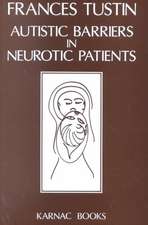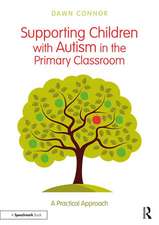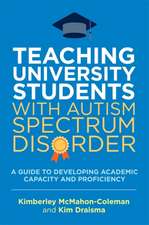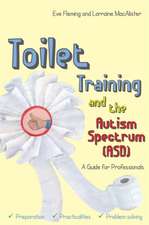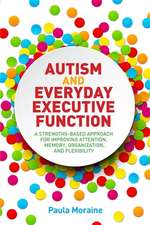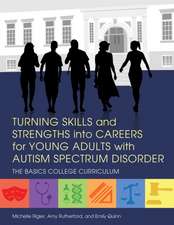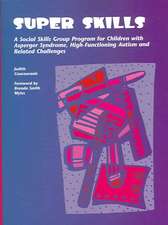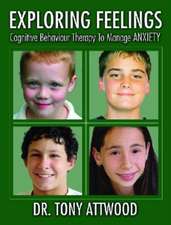The Little Book of the Autism Spectrum: Little Book
Autor Dr Samantha Todden Limba Engleză Hardback – 12 iun 2013
Peering through the "Autism lens" allows us to change in terms of the way we deal with autism as a society and in education. Evidence-based support and strategies enable us to develop young people's ability to interact with the social world, dispensing of the anxiety that often accompanies it.
The Little Book of the Autism Spectrum allows anyone who lives or works with children with autism to understand their world through an ‘autism lens’. The most positive step we can take with a child with autism is to understand the condition, and the world in general, from his or her point of view. This book develops the knowledge and delivers evidence-based strategies for communication, social interaction and the emotional, behavioral and sensory challenges faced by young people with autism.
“A concisely written work that will be especially helpful for parents trying to get ‘up to speed’ when their children are newly diagnosed, it covers a wealth of material quickly without over simplifying.”—Lars Perner, PhD, Assistant Professor of Clinical Marketing, Marshall School of Business, University of Southern California
“This book is a must-read for parents, professionals and young people with an interest in autism. It is a welcome addition to the existing literature, providing a clear, concise and very readable overview.”—Dr Paul Wallis, Director of Psychological Services, CAMHS Directorate, Central Manchester University Hospitals NHS Foundation Trust
“A great book, packed full of facts and information.”—Pam Smith MBPsS, BMus(Hons), BSc(Hons), PGCE, Postgraduate Certificate in Professional Studies in Education (Autism). Special School Teacher, Surrey
“This excellent little book will be appreciated equally by parents and carers as well as by professionals.”—Eric Taylor, Educational Psychologist, Persona EPS Ltd
Dr Samantha Todd is a clinical psychologist who works with children and adolescents with learning disabilities. She also provides regular training for teachers and children’s services, and has co-developed a program for behavioral difficulties, “Riding the Rapids: Living with Autism or Disability”™.
The Little Book of the Autism Spectrum allows anyone who lives or works with children with autism to understand their world through an ‘autism lens’. The most positive step we can take with a child with autism is to understand the condition, and the world in general, from his or her point of view. This book develops the knowledge and delivers evidence-based strategies for communication, social interaction and the emotional, behavioral and sensory challenges faced by young people with autism.
“A concisely written work that will be especially helpful for parents trying to get ‘up to speed’ when their children are newly diagnosed, it covers a wealth of material quickly without over simplifying.”—Lars Perner, PhD, Assistant Professor of Clinical Marketing, Marshall School of Business, University of Southern California
“This book is a must-read for parents, professionals and young people with an interest in autism. It is a welcome addition to the existing literature, providing a clear, concise and very readable overview.”—Dr Paul Wallis, Director of Psychological Services, CAMHS Directorate, Central Manchester University Hospitals NHS Foundation Trust
“A great book, packed full of facts and information.”—Pam Smith MBPsS, BMus(Hons), BSc(Hons), PGCE, Postgraduate Certificate in Professional Studies in Education (Autism). Special School Teacher, Surrey
“This excellent little book will be appreciated equally by parents and carers as well as by professionals.”—Eric Taylor, Educational Psychologist, Persona EPS Ltd
Dr Samantha Todd is a clinical psychologist who works with children and adolescents with learning disabilities. She also provides regular training for teachers and children’s services, and has co-developed a program for behavioral difficulties, “Riding the Rapids: Living with Autism or Disability”™.
Din seria Little Book
-
 Preț: 33.70 lei
Preț: 33.70 lei -
 Preț: 69.14 lei
Preț: 69.14 lei - 6%
 Preț: 42.58 lei
Preț: 42.58 lei -
 Preț: 69.65 lei
Preț: 69.65 lei -
 Preț: 75.24 lei
Preț: 75.24 lei -
 Preț: 41.88 lei
Preț: 41.88 lei -
 Preț: 43.32 lei
Preț: 43.32 lei -
 Preț: 71.39 lei
Preț: 71.39 lei -
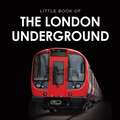 Preț: 59.80 lei
Preț: 59.80 lei -
 Preț: 69.44 lei
Preț: 69.44 lei -
 Preț: 69.00 lei
Preț: 69.00 lei -
 Preț: 100.40 lei
Preț: 100.40 lei -
 Preț: 100.40 lei
Preț: 100.40 lei - 6%
 Preț: 69.09 lei
Preț: 69.09 lei -
 Preț: 100.40 lei
Preț: 100.40 lei - 24%
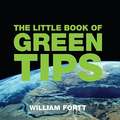 Preț: 14.53 lei
Preț: 14.53 lei - 24%
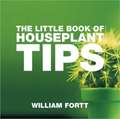 Preț: 14.53 lei
Preț: 14.53 lei - 25%
 Preț: 16.33 lei
Preț: 16.33 lei
Preț: 85.55 lei
Nou
Puncte Express: 128
Preț estimativ în valută:
16.37€ • 16.77$ • 13.62£
16.37€ • 16.77$ • 13.62£
Carte disponibilă
Livrare economică 26 februarie-12 martie
Livrare express 11-15 februarie pentru 23.10 lei
Preluare comenzi: 021 569.72.76
Specificații
ISBN-13: 9781781350898
ISBN-10: 1781350892
Pagini: 203
Ilustrații: Illustrations
Dimensiuni: 127 x 175 x 25 mm
Greutate: 0.32 kg
Editura: INDEPENDENT THINKING
Seria Little Book
Locul publicării:United Kingdom
ISBN-10: 1781350892
Pagini: 203
Ilustrații: Illustrations
Dimensiuni: 127 x 175 x 25 mm
Greutate: 0.32 kg
Editura: INDEPENDENT THINKING
Seria Little Book
Locul publicării:United Kingdom
Cuprins
Acknowledgements
Foreword
Preface
Part One: Understanding the Autism Spectrum
1. Introduction to the Autism Spectrum
2. The Diagnosis of Autism
3. A Different Perspective on Autism: Neurodiversity
4. Developing Your Autism Lens
5. Talking with Children and Young People about Autism
Part Two: Developing Skills and Promoting Well-Being in Children and Young People with Autism
6. What Works and Who Can Help?
7. Autism-Friendly Educational Settings
8. Developing Social Skills
9. Developing Communication and Understanding
10. Emotional Well-Being and Mental Health
Part Three: Working with Behaviour
11. Understanding and Managing Challenging Behaviours
12. Feeding and Eating Issues
13. Sleep Difficulties
14. Aggression and Self-Injury .
15. Managing Repetitive and Restricted Behaviours and Routines
16. Managing Sensory Issues
Final Remarks
Glossary
References
Further Reading and Resources
Index
Foreword
Preface
Part One: Understanding the Autism Spectrum
1. Introduction to the Autism Spectrum
2. The Diagnosis of Autism
3. A Different Perspective on Autism: Neurodiversity
4. Developing Your Autism Lens
5. Talking with Children and Young People about Autism
Part Two: Developing Skills and Promoting Well-Being in Children and Young People with Autism
6. What Works and Who Can Help?
7. Autism-Friendly Educational Settings
8. Developing Social Skills
9. Developing Communication and Understanding
10. Emotional Well-Being and Mental Health
Part Three: Working with Behaviour
11. Understanding and Managing Challenging Behaviours
12. Feeding and Eating Issues
13. Sleep Difficulties
14. Aggression and Self-Injury .
15. Managing Repetitive and Restricted Behaviours and Routines
16. Managing Sensory Issues
Final Remarks
Glossary
References
Further Reading and Resources
Index
Recenzii
"As head teacher of a specialist support primary school which has amongst its numbers over 50 pupils with autism I can see a place for this book on the shelves of our resource library. It would be a useful addition to support both parents and practitioners. Easy to read, with bite size nuggets of useful information, the book flows logically, touching on the key areas involved in supporting children with autism. The book provides a basic introduction to the subject of autism, an overview and some manageable strategies and tips to implement.
"Dr Samantha Todd has set out in an easily accessible and un-daunting way a useful guide book or check list for the teacher wishing to know they have ‘got it right.’ The book details the key areas that need to be in place to maximize the potential for pupils to make progress and goes on to tell you what you can do to support those learning areas."—Andy Pitts M.Ed autism, Head Teacher, The Birches Specialist Support Primary School, Manchester
"This is a very nice, concisely written work that will be especially helpful for parents trying to get 'up to speed' when their children are newly diagnosed. The book covers a wealth of material quickly without over simplifying. Highly recommended both for finding practical solutions and for better understanding the 'big picture' of what an individual on the spectrum may be experiencing."—Lars Perner, PhD Assistant Professor of Clinical Marketing, Marshall School of Business, University of Southern California
"This excellent little book, cogently written by Dr Samantha Todd fills a useful gap in the literature about autism spectrum disorder. The author, a clinical psychologist working in Manchester, has written a very accessible book which will be appreciated equally by parents and carers as well as by professionals working in children’s services. The many themes covered in the book will be particularly relevant to those working in schools and early years settings responsible for autistic children, especially teachers and support staff.
"The book is helpfully divided into three sections namely:
1. Understanding the autism spectrum
2. Developing skills and promoting well-being in children and young people with autism
3. Working with behavior
"Beginning with the assessment process and covering the many questions facing anxious parents at the time of diagnosis, the author helpfully demystifies much of the jargon and the plethora of medical labels which cause confusion for families and also many professionals. There follows a thoughtful account of the benefits to society of neurodiversity and the positive contribution made by people who are thought to be unusual or different.
"For me, however, the key section is found in Chapter 4 where the author introduces the concept of 'the autism lens', a theme which involves the reader viewing aspects of home and school life specifically from the viewpoint of the youngster with autism. This metaphor is developed throughout the remainder of the book and enables the reader to appreciate the subtle differences which impact the lives of children and young people with autism.
"The third section of the book focuses on working with aspects of behavior and will be helpful to everyone attempting to understand, analyze and manage behavior that is considered challenging in the home and the wider community including educational settings.
"The Little Book also contains humorous illustrations of real-life situations and key learning points are provided as a helpful summary to each chapter. Furthermore, the glossary and references are useful aides for follow-up. Personally I found The Little Book of the Autistic Spectrum a fascinating read and as a practitioner educational psychologist I will be recommending it to parents, school staff and colleagues as I believe it gives illuminating insight and plenty of sound practical advice which will be helpful to those who support children with ASD."—Eric Taylor, Educational Psychologist, Persona EPS Ltd
"This book is a must-read for parents, professionals and young people with an interest in autism. It is a welcome addition to the existing literature on autism providing a clear, concise, and very readable overview of many of the key aspects to aid the reader in a broad understanding of autism. Through clear text, simple and effective illustrations, and regular key summaries this book guides the reader sensitively and thoughtfully through the facts, the impact, and solutions for working with young people with autism. The author places the young person at the center of all the chapters focusing on the importance of parents and professionals trying to place themselves in the world of the young person.
"The later chapters on intervention illustrate this beautifully with multiple real-life examples to guide readers through many of the key issues faced by young people with ASD. There is a strong ethos of inclusion and acceptance throughout the book allowing the reader to place the young person at the center of their thinking. This non-expert, nonjudgmental approach is again a welcome break from the plethora of scientific writing on autism which may not always aid a broader audience in their understanding of autism. The book ends with a clear, practical glossary of terms, well-selected references, and helpful weblinks, to guide readers towards further information and support."—Dr Paul Wallis, Director of Psychological Services,CAMHS Directorate, Central Manchester University Hospitals, NHS Foundation Trust
"This is a great book for people who want to know about autism. It is packed full of facts and information and signposts readers to other books, research, and organizations who can provide further help. The key point reiterated throughout this book is that people with autism are individuals with different personalities, likes and dislikes and that there is no 'one size fits all' approach that will magically work for every autistic person. The focus upon the different ways in which individuals with autism may think about and experience the world really encourages the reader to respond creatively. By using statements from autistic individuals to explain their perspective the author helps readers to gain insight into situations and behaviors which may appear baffling or unusual from the outside but make much more sense when viewed through an 'autism lens'.
"The book contains information on most key areas that can be challenging for people with autism from communication difficulties, 'mindblindness', problems with eating, sleeping and tolerating situations due to sensory overload to self-injurious behavior, psychiatric vulnerabilities, and repetitive behaviors. Each section gives good, sound, practical advice on ways of approaching or managing the difficulties and offers sources of further information and advice. This is no mean feat for such a comprehensive book and is to be applauded.
"The book is written in simple language without jargon which makes it easy to read and the key points at the end of each chapter help to pull everything together. The tone is just right and is informative, factual, and interesting. The glossary is excellent and the references are extensive and wide ranging. My only surprises were the omission of Division TEACCH (although visual schedules are well covered) and that the National Autistic Society was not mentioned as a resource for training, publications, and parental support; notably their helpline and Early Bird/Early Bird Plus parent training schemes.
"As a parent of a young man with Aspergers I would have welcomed this book wholeheartedly when he was younger and it probably would have helped me through many anxious times. As a teacher who has worked for many years with children and adolescents with autism I loved the warmth and empathy with which the author talks about the people with whom she works and her complete and utter dedication to these very special individuals."—Pam Smith MBPsS, BMus(Hons), BSc(Hons), PGCE, Postgraduate Certificate in Professional Studies in Education (Autism). Special School Teacher, Surrey
Notă biografică
Samantha Todd: Dr Samantha Todd is a clinical psychologist who works with children and adolescents with learning disabilities. She also provides regular training for teachers and children’s services, and has co-developed a programme for behavioural difficulties, “Riding the Rapids: Living with Autism or Disability”™. Dr Todd has a BA Hons, Psychology from the Universtiy of Manchester and a Doctorate in Clinical Psychology from the University of Wales, Bangor.
Ian Gilbert is one of the UK's leading educational innovators, speakers and writers with twenty years experience working with young people and educationalists around the world. He is the founder of Independent Thinking Ltd, the editor of the Independent Thinking Press and the author of a number of titles including Why Do I Need a Teacher When I've Got Google?. His book The Little Book of Thunks won the first education book award from the Society of Authors for 'an outstanding example of traditionally published non-fiction that enhances teaching and learning'.
Ian Gilbert is one of the UK's leading educational innovators, speakers and writers with twenty years experience working with young people and educationalists around the world. He is the founder of Independent Thinking Ltd, the editor of the Independent Thinking Press and the author of a number of titles including Why Do I Need a Teacher When I've Got Google?. His book The Little Book of Thunks won the first education book award from the Society of Authors for 'an outstanding example of traditionally published non-fiction that enhances teaching and learning'.
Extras
Foreword by Ian Gilbert
It’s a trivial thing I know, but it’s the closest I can get to understanding what it’s like.
I’m fortunate enough to be able to go the gym several times a week once the three girls in my life have gone off to school (that’s two students and a vice principal in case you’re trying to do the maths). I have a set routine that takes me exactly an hour. Treadmill. Weights. Floor mat. Treadmill. There’s a
music system there that I can link via Bluetooth to my iPhone and listen on Spotify to the sort of ‘work out’ music men half my age would turn their noses up at all bass and shouting. All in all, as routines go, it’s doing the trick – helping me stay fit, helping me justify the expense of the various technologies I’ve invested in, and helping me fight at least some of the signs of aging that a decent moisturiser can’t reach.
I go there on Mondays, Wednesdays, and Fridays. Just after seven. Usually I’m the only person there. But …
Sometimes I’m not. Sometimes there is someone there before me. And they are on my treadmill. And they are listening to their music. Or have the television on. Breakfast TV. In Cantonese.
And I know it’s irrational. I know it’s unreasonable. I know I shouldn’t feel that way. After all, share and share alike. But I get very angry and I what I want more than anything else is for that person on my machine to trip up unexpectedly and allow me to step over their prostrate body as it spins off the
treadmill so I can take my rightful place.
You think that’s bad? I know someone who has to have her boxed set of coloured pens with each pen in exactly the right order at all times. If she mislays one, she is unable concentrate until it is found again. If someone asks to borrow one
she has an anxiety attack. You can even freak her out by shuffling her pens around in your mind!
That apparently irrational way of looking at everyday things is the merest hint at what life seen through the lens of someone on the autism spectrum is like. It’s not an illness. It’s not a disease. It’s a way of looking and thinking and responding that is different from ‘the norm’ (whatever that is – in many ways we are all somewhere on that spectrum) but that is valid and makes complete sense to the boy or girl experiencing it.
Three things are striking when you start to try and find out how many people are on the autism spectrum. The first is that no one knows. The second is that it affects boys much more than it affects girls. Thirdly, it is a great deal more common than was first thought, especially when recent understanding helps move us away from the ‘Is he; isn’t he?’black and white term ‘autistic’ and towards the more nuanced approach behind the ‘spectrum’ concept.
This book is Independent Thinking’s first foray into the world of special educational needs, something that we feel is long overdue. With the expert guidance of Dr Samantha Todd, the reader will not only get a feel for life through the ‘autism lens’ as she calls it but a better understanding of how
to work to bring the best out of all children who find themselves
on that spectrum.
And, who knows, it may just help with everyone who finds themselves somewhere along that spectrum and wants their treadmill, green pen, or life back.
Ian Gilbert, Hong Kong
Textul de pe ultima copertă
THE LITTLE BOOK OF THE AUTISM SPECTRUM allows anyone who lives or works with children with autism to understand their world through an ‘autism lens’.
The most positive step we can take with a child with autism is to understand the condition, and the world in general, from his or her point of view. This book develops the knowledge and delivers evidence-based strategies for communication, social interaction and the emotional, behavioral and sensory challenges faced by young people with autism.
“A concisely written work that will be especially helpful for parents trying to get ‘up to speed’ when their children are newly diagnosed, it covers a wealth of material quickly without over simplifying.”
Lars Perner, PhD, Assistant Professor of Clinical Marketing, Marshall School of Business, University of Southern California
“This book is a must-read for parents, professionals and young people with an interest in autism. It is a welcome addition to the existing literature, providing a clear, concise and very readable overview.”
Dr Paul Wallis, Director of Psychological Services, CAMHS Directorate, Central Manchester University Hospitals NHS Foundation Trust
“A great book, packed full of facts and information.”
Pam Smith MBPsS, BMus(Hons), BSc(Hons), PGCE, Postgraduate Certificate in Professional Studies in Education (Autism). Special School Teacher, Surrey
“This excellent little book will be appreciated equally by parents and
carers as well as by professionals.”
Eric Taylor, Educational Psychologist, Persona EPS Ltd
Dr Samantha Todd is a clinical psychologist who works with children and adolescents with learning disabilities. She also provides regular training for teachers and children’s services, and has co-developed a programme for behavioural difficulties, “Riding the Rapids: Living with Autism or Disability”™.
Descriere
Allows anyone who lives or works with children with Autism to see the world as they do.



